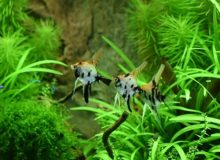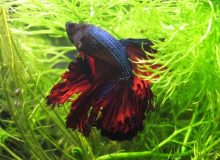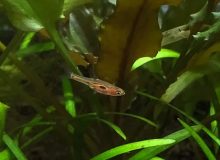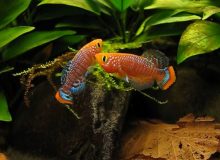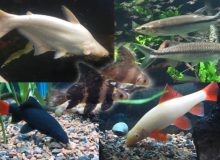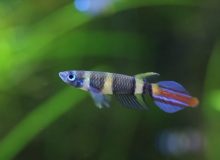Aquarium Fish Food Guide: Types, How to Choose, and Feeding Tips
Feeding your aquarium fish may seem simple, but choosing the right food can make a world of difference to their health, coloration, and lifespan. With a vast array of fish food types on the market—from flakes and pellets to live, frozen, and freeze-dried options—knowing what to feed, how often, and how much can be overwhelming for both beginners and seasoned aquarists. In this comprehensive guide, we’ll break down the main types of fish food, how to select the best one for your tank’s species, and feeding techniques that keep your fish thriving while avoiding common pitfalls like overfeeding and water pollution.
- Which types of foods should I choose?
- What is a well-balanced diet for fish?
- Dry foods & flakes
- Live food – harvest from the wild or buy
- First foods for fry – make your own at home
- Vegetable foods
- Other types of foods
- How much food should aquarium fish be given?
Which types of foods should I choose?
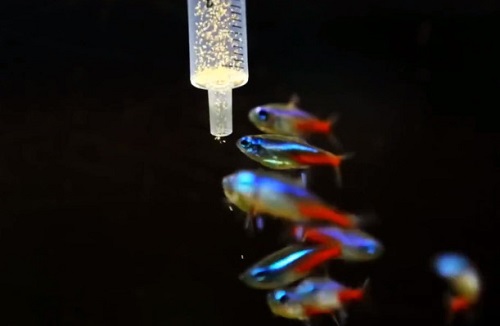
It should be noted that not all fish will thrive if fed the same diet. For example, you wouldn’t think of feeding a cat with lettuce or a rabbit with beefsteak; it’s similar with fish. Some species of fish require a vegetable diet, while others thrive on a combination of both.
- Meat-eaters are referred to as “Carnivores”
- Vegetable-eaters are referred to as “Herbivores”
- Fish that eat a general diet, e.g., a mix of both, are referred to as “Omnivores”
- Detritus-eaters are referred to as “Limnivores”
There are many different types of dry foods, such as tablets, sticks, granules, wafers, and flakes, among others. All of these dry foods can be bought in various compositions, depending on the type of fish you want to feed.
For example, I use sinking algae wafers for my Plecostomus (mainly herbivorous, although they will eat various worms and other foods), and surface feeders, such as my Gouramis, are fed with high-quality flakes, while my Green Terror (Cichlid, usually carnivorous) likes to feed on the algae wafers and the flakes, as well as live food.
Another important factor is diet; it is a fact that a poorly balanced diet will be responsible for the fish’s inability to fight off diseases. If a fish is to live a healthy life it must have a well-balanced diet.
What is a well-balanced diet for fish?
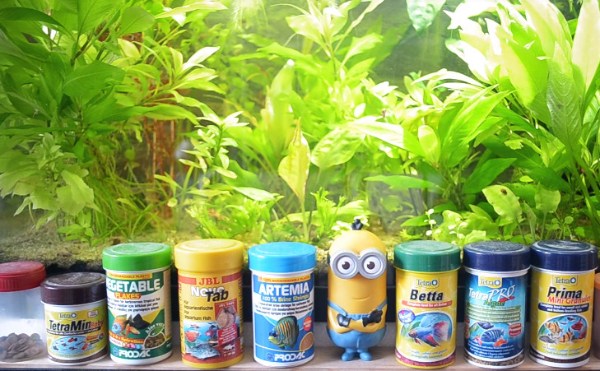
Fish need to have all the right ingredients in their diet. These should include vitamins, minerals, and trace elements, as well as fats, fiber, protein, and carbohydrates.
The typical analysis of a good quality flake food for a general diet, e.g., omnivorous fish, should read something like:
- Protein 35%
- Fat 2–5%
- Fiber 3–8%
The typical analysis of a good quality flake food for carnivorous fish, e.g., meat-eating fish, should read something like:
- Protein over 45%
- Fat 3–6%
- Fiber 2–4%
The typical analysis of a good quality flake food or tablet or wafer-type food for herbivorous fish, e.g., plant-eating fish, should read something like:
- Protein 15%
- Fat 1–3%
- Fiber 5–10%
As with most foods for animals or humans, there is little to indicate how rich the food is in vitamins. There is usually a list of vitamins on the label, but this is often unclear to the average person.
Calcium and phosphorus should be found in fishmeal, which are particularly important for the development of the fish’s bony skeleton.
The fat content is important and should be as low as possible, as fat is unhealthy for all animals, even more so for fish. Fat solidifies in cold conditions, which is particularly problematic for cold-blooded fish. Therefore, the fat consumed by the fish will coagulate more readily, leading to fatty deposits in the tissues, which can cause degeneration of internal organs such as the liver.
Dry foods & flakes
Great advantages to using dry foods
 TetraMin Nutritionally Balanced Tropical Flake Food #ad
TetraMin Nutritionally Balanced Tropical Flake Food #ad
There are great advantages to using dry foods; they are readily available and easily stored, reducing the need for frequent purchases. The risk of disease or parasites being introduced into the aquarium with the food is completely eliminated with dry foods.
The major manufacturers of dry fish foods have formulated their flakes from natural ingredients, including vegetable matter, ensuring sufficient quantities of essential trace elements.
Although it should be noted that the vitamin content has a limited shelf life, the vitamin content is usually guaranteed until the “best by” date on the container. Minerals and trace elements have a long shelf life and are not adversely affected by prolonged storage.
Most manufacturers display a list of ingredients as well as a typical analysis on their packaging; you should look for this label when buying food for your fish. It’s the foods that are labeled as “complete balanced diets” that you need to look for.
Could I use dry foods as a staple diet for my fish?
There was a time when dry foods were only used out of necessity because their quality could not always be assured. Even now, modern flake foods are all too often ignored or dismissed as being less than a complete diet. Surprisingly, many fishkeeping books seem to take a skeptical view of dry foods. This skepticism is unwarranted.
Nowadays it’s not too difficult to provide good quality flake food. Most flake foods are of unquestionable origin, are scientifically developed, and are without a doubt a complete diet. Commercial foods have progressed to the point where most species can live a lifetime on a varied diet of high-quality dry foods.
Having said that, I’ve been using dry and flake foods for about ten years, and my fish have always been lively, colorful, and healthy. My experience shows, with confidence, that you can provide your fish with dry and flake foods, which have an adequate quantity of all the vitamins, minerals, and trace elements, as well as all the other necessary ingredients that are needed for a staple diet.
Not all dry foods are designed as a staple diet
Some foods such as dried daphnia, bloodworms, or tubifex worms, as well as live and frozen foods, do not necessarily contain all the vitamins and trace elements. They are fine to supplement a staple diet, but should not be the only food you feed to your fish; otherwise, dietary deficiencies may develop. These problems can be corrected by regular feeding with a high-quality flake food.
Live food – harvest from the wild or buy
Most species of fish will thrive on live foods, many of which can be purchased at local aquatic stores. Live food that is fed to your fish should be bought or cultured if you have the expertise. Live food that has been caught from the wild, for example, a garden pond, could introduce diseases into the aquarium. The danger of disease being introduced this way is also increased because of the warmer water of the tropical aquarium.
The best-known live foods that are available are:
Daphnia
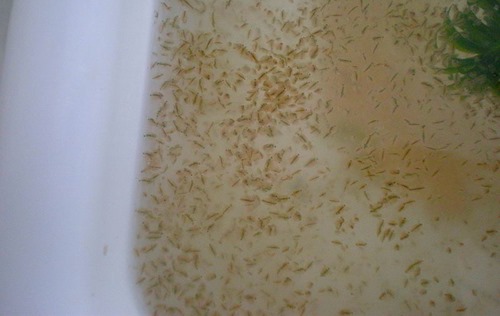
Buy 500 Live Daphnia Magna #ad
These are small crustaceans and are sometimes referred to as “water fleas” although they are not really fleas at all. They can be found in ponds during spring and summer, and are often sold in aquatic shops. They have limited nutritional value, but fish love them, and they will certainly keep fit chasing and catching them.
Bloodworms
 Tetra BloodWorms Freeze-Dried Food #ad
Tetra BloodWorms Freeze-Dried Food #ad
The larvae of midges are very nutritious and can be found at the bottom of ponds or even small puddles. You may have seen them almost anywhere that holds any amount of water as small wriggling red worm-like creatures about 0.5 inches (1.3 cm) long.
Tubifex Worms
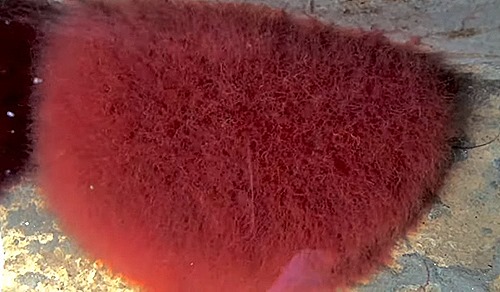
It may seem surprising, considering that these worms live in muddy and unsanitary conditions, that they are recommended as food. Nonetheless, they are a popular choice when it comes to fish treats, although fish should not be fed too much or too often with tubifex because of the high protein content.
Earthworms
These provide an excellent food and are full of protein, making them suitable for larger fish, such as large Cichlids. One reason why they are not used as often as one might think is that they must be chopped up before feeding.
You could try your local fishing tackle shop for these; otherwise, if you obtain your own, make sure you thoroughly clean them in fresh water. Before they can be fed to your fish you must place them in a box and allow enough time for them to clear out their intestinal tract of sand. Remember to keep them moist as well.
First foods for fry – make your own at home
Infusoria
The fry of egg-layers are usually first fed on “Infusoria”; this is an outdated term, but is still used by fish keepers to represent a variety of minute or microscopic animal and vegetable organisms, which develop in an infusion of decaying organic matter.
Infusoria cultures can be prepared quite simply; the spores are airborne so there is no need to obtain starter cultures. All you need is an open jar three-quarters full of aquarium water, to which you add either a small amount of potato (lightly boiled, if preferred), banana skin, dried lettuce leaves, or hay; allow this to stand for about a week, after which it will become cloudy with Infusoria.
When it is time to feed the fry just pour a little of this cloudy water into the aquarium and refill the jar with aquarium water. If you have a few of these cultures active at once it will give you a constant supply of Infusoria.
 Instant Baby Brine Shrimp Eggs #ad
Instant Baby Brine Shrimp Eggs #ad
Brine shrimps
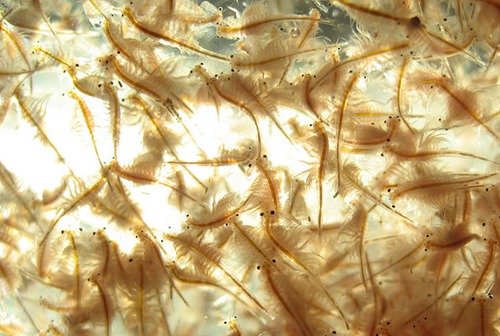
These marine shrimps, which are also available in dried form, can easily be cultivated from eggs that are available from aquatic shops. They will be supplied in sealed airtight containers and it is imperative that they remain in a dry and cool place; otherwise, damp conditions will prevent hatching.
Take a one-liter plastic bottle and half fill it with tap water, maintained at 75°F (24°C), add to it one and a half teaspoons of salt (aquarium or sea salt preferably), then add a quarter of a teaspoon of the eggs. You will then need to place a piece of an airline into the bottle and attach the other end of the airline to an air pump.
Run the air pump, which will circulate the eggs in the bottle, after about 36 hours the eggs will have hatched and the shells will float to the surface, at which point you can remove the airline. Wait for a further 30 minutes and you will see the newly hatched brine shrimps at the base of the bottle.
For feeding, just place a plastic tube into the bottle and siphon the minute shrimps through a clean, dry linen, nylon, or paper towel filter. They can now be washed in fresh water and fed to the fish.
 Premium Grade Brine Shrimp Eggs Minimum Hatch Rate 90% #ad
Premium Grade Brine Shrimp Eggs Minimum Hatch Rate 90% #ad
Microworms
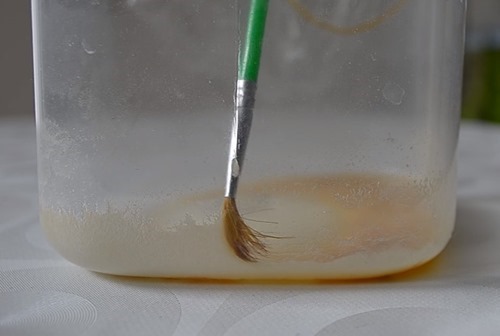
This minute worm is also bought as a culture; you may be able to obtain a starter culture from another aquarist. Microworms feed on the surface of cereal-based foods, so you will need to mix up some oatmeal with a little water (porridge); be sure to use only water. Let the mixture cool then spread a layer of it, about 1 cm (0.4 inches) thick, onto the base of a container or saucer, take a small spoonful of the culture and place it onto the porridge, put a lid or cover (with a few small air holes) over the container, and keep it in a warm place 70–75°F (21–24°C).
After a few days, the worms will have multiplied and will be climbing up the sides of the container you can wipe these off with a small brush and feed them directly to the fry.
You will need to start fresh cultures after about five days, as the culture begins to spoil. All you need to do then is make a fresh porridge mix, and place some of your old cultures onto the top of your new porridge mix. If you use about three containers you will have a succession of cultures for continuous use.
Vegetable foods
There are many fish whose diet consists mainly or entirely of vegetable foods. Many Catfish belong in this category, along with some livebearing species, and some Carps and Minnows. You usually find that these types of fish are particularly fond of algae.
Some Catfish especially can often be seen rasping on objects in the aquarium, and even on the aquarium glass itself where algae has grown. As long as this algae is not out of control it can be safely left in the aquarium for these fish to feed on. However, since it is not in great abundance, you will need to offer your fish extra vegetable matter to supplement their diet.
There are a great variety of vegetable foods that are suitable to feed to your fish, some possibilities include lettuce and spinach leaves, which must be blanched (briefly boiled) prior to feeding to your fish, slices of cucumber, peas, and there are a number of excellent dried foods available, which include all the right ingredients for vegetarian fish.
Other types of foods
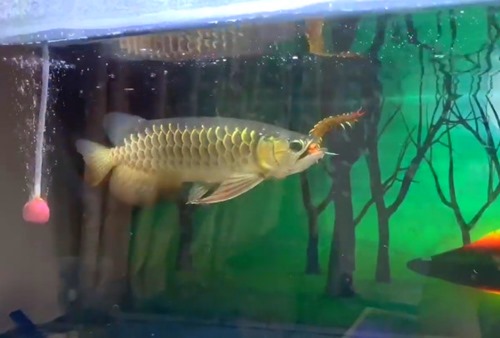
The Arowana eating a centipede
There are some foods that may not have been considered by newcomers to the hobby, which aren’t typical or commercially available for pet fish, for example, meat, other fish, and crustaceans. These foods could be considered as “solid” foods, and some fish, in particular large Cichlids, do like to have solid food.
Feeding your fish with high-quality flake and live food and other foods is still recommended, but occasionally you could try small pieces of beef heart (no fat), pieces of mussel or prawn, and pieces of fish, or, if preparing fish for a meal, reserve a small, uncooked piece for your fish.
If you are a fisherman, it is not wise to feed your fish with fish that you have caught from natural bodies of freshwater, as this risks introducing diseases into your aquarium. A simple rule is that you should feed freshwater fish with saltwater fish or saltwater fish with freshwater fish. If you follow this rule you will prevent any disease from cross-contaminating.
One thing that you must not feed to your fish is bread; this will swell up in their stomach and could cause problems.
How much food should aquarium fish be given?
The most important point to be made is not to overfeed. When a fish eats more food it produces more excreta, and when combined with uneaten food leftover from feeding too much, it causes a problem.
All of this waste will fall to the aquarium floor, and start to decompose, in turn, this will produce pollutants that no fish can tolerate, and could ultimately lead to fatalities. In simple terms, the easiest way to aquarium mismanagement is through overfeeding.
The rule of thumb is to feed your fish the amount they can consume within 3–4 minutes, then remove any leftover food. I feed my fish two times a day. You can feed your fish as many times a day as you want, but higher feeding frequency should involve reducing the amount per feeding to adhere to this rule.

